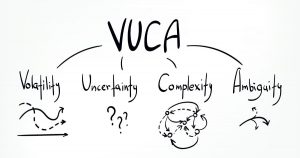We seem to be at a pretty low point right now:
- Billions of people are confined at home.
- Economists are predicting a disaster and seem to think 2020 will probably be worse than what most of us can remember.
- The behavior and effects of this novel coronavirus are still partly unknown. It could still mutate and become more dangerous, for example.
And, most amazing of all: the situation has been changing dramatically every 1 or 2 weeks.
I am starting this new series on supply chain risk management. It may run up to 8 or 10 articles, in total.
In this first post, I’d like to introduce two important terms, VUCA and Black Swan.
Sourcing may never be the same again…
Here is what went through the heads of most procurement professionals in companies that import products from China:
- Oh, there is a serious health concern in central China – let’s not go there.
- Wow, 40 million people got locked down! Do we have anybody stuck up there? What impact on China’s GDP?
- Production will have to restart a bit later. Waiting for more information. Should we trust what the WHO says?
- Very hard to get all the staff and materials needed! Massive disruption of our supply chain! And we can’t even go to China now!
- Let’s push all Chinese suppliers to ship as early as possible. Go go go!
- Oh, wait! Stop! We have infection cases too, and stores are getting closed — put all shipments on hold!
- Will we be stuck with all this inventory now? When will demand materialize again? How long will we all be home?
Many more people are now open to the idea that a good business can’t simply be built on a “find a supplier that passes the audit and that offers a good price” approach. This seemingly unprecedented crisis is causing many decision-makers to rethink their sourcing strategy.
Here are two questions related to supply chain risk management that I’d like to focus on:
Have you worked on mitigating VUCA?
VUCA stands for these 4 concepts (I added my comments in blue):
- Volatility: the nature and dynamics of change, and the nature and speed of change forces and change catalysts. (As I wrote above, the situation changes every week!)
- Uncertainty: the lack of predictability, the prospects for surprise, and the sense of awareness and understanding of issues and events. (Nobody knows where we are headed. Quick recovery, or 2 years of various restrictions to people movements? A second wave? Deflation or hyper-inflation? And so forth.)
- Complexity: the multiplex of forces, the confounding of issues, no cause-and-effect chain and confusion that surrounds organization. (For example, how with the USA respond? Will they lift tariffs temporarily? Will they crack down hard on Huawei? Which of these opposing forces, if any, will prevail?)
- Ambiguity: the haziness of reality, the potential for misreads, and the mixed meanings of conditions; cause-and-effect confusion. (Fake infection numbers from several countries, “it’s like the flu”, “foreigners are importing infections into China”, and so on.)
I’d say we are in a VUCA storm right now!
Last summer, we mentioned VUCA in our webinar on developing a low-risk supply chain, at 7’30”. Gathering information about your supply chain and taking appropriate measures (e.g. backup sources) help reduce your exposure to VUCA. We’ll go deeper into this in upcoming articles in this series.
Knowledge, understanding, and preparation help mitigate VUCA. And I see plenty of companies lacking all three.
Have you planned for Black Swans?
Let’s focus on the “U” in “VUCA”. One of my favorite writers, Nassim Nicolas Taleb, defined a Black Swan as follows:
What we call here a Black Swan (and capitalize it) is an event with the following three attributes.
First, it is an outlier, as it lies outside the realm of regular expectations, because nothing in the past can convincingly point to its possibility. Second, it carries an extreme ‘impact’. Third, in spite of its outlier status, human nature makes us concoct explanations for its occurrence after the fact, making it explainable and predictable.
I stop and summarize the triplet: rarity, extreme ‘impact’, and retrospective (though not prospective) predictability. A small number of Black Swans explains almost everything in our world, from the success of ideas and religions, to the dynamics of historical events, to elements of our own personal lives.
Here is an example of a Black Swan that hurt many supply chains:
The 2011 Japan earthquake & tsunami
In 2011, an earthquake and a tsunami hit Nort-East japan. Here is Wikipedia’s description:
It was the most powerful earthquake ever recorded in Japan, and the fourth most powerful earthquake in the world since
modern record-keeping began in 1900. The earthquake triggered powerful tsunami waves that may have reached heights of up to 40.5 meters (133 ft) in Miyako in Tōhoku’s Iwate Prefecture, and which, in the Sendai area, traveled at 700 km/h (435 mph) for up to 10 km (6 mi) inland. Residents of Sendai had only eight to ten minutes of warning, and more than a hundred evacuation sites were washed away.
Is it a Black Swan? It certainly seems to fit the description:
- It is rare (there are many earthquakes every year in Japan, but was the most power ever recorded there)
- It had an extreme impact (about 16,000 deaths, a level-7 meltdown in 3 nuclear reactors, etc.)
- People can explain it retroactively: for example, some people had warned that the sea walls were not high enough.
Taleb mentioned this major incident on his ‘notebook’ (note No. 142).
The Japanese Nuclear Commission had the following goals set in 2003: ” The mean value of acute fatality risk by radiation exposure resultant from an accident of a nuclear installation to individuals of the public, who live in the vicinity of the site boundary of the nuclear installation, should not exceed the probability of about 1×10^6 per year (that is , at least 1 per million years)”.
That policy was designed only 8 years ago. Their one in a million-year accident almost occurred about 8 year later (I am not even sure if it is at best a near miss).
Taleb’s book ‘The Black Swan’ includes mentions of many similar predictions. Events that, according to elaborate mathematical models, should happen once in several lifetimes of our universe… and that did happen a few years later.
*****
The conclusion is that one simply can’t model all possible disruptions in the years to come. A mega-tsunami 9 years ago, a global pandemic this year, maybe something serious again in a few years.
One can imagine many scenarios — will we watch a Hollywood movie about a mega-storm (exacerbated by global warming, of course) that devasts the US East Coast? — and we will go over this in the next article in this series.
The key is actually to get ready for such disruptions. Expect them. And structure your business systems based on this expectation.
P.S.
Learn more about Supply Chain Risk Reduction Strategies here.
Do you need help with supply chain issues or have something else that is troubling you?




